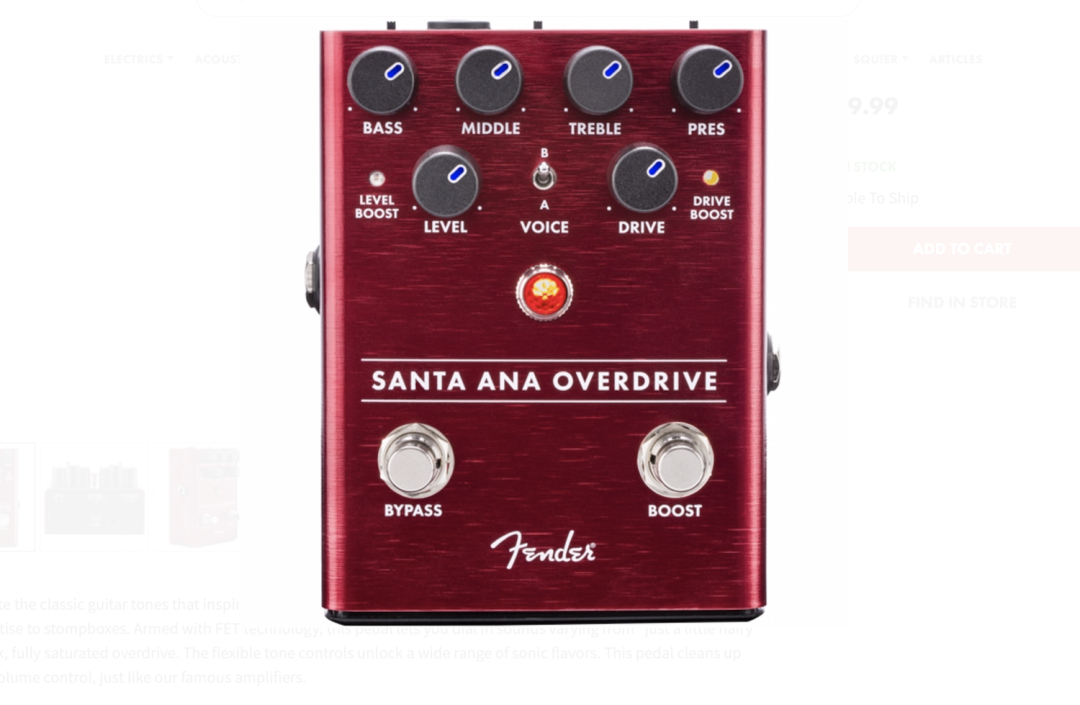Every guitarist deserves an inspiring overdrive pedal to push their tones into new territory. Whether you just want to boost a solo or push an amp into gritty distortion, overdrive is a mainstay effect that everyone should have. The Fender Santa Ana is an easy-to-set and versatile overdrive pedal upon review, with just enough features to set it apart from the riffraff.
Fender’s Stompboxes Have Been Making a Big Name for Themselves
Obviously, Fender is best known for its guitars and its amplifiers — that’s just how it goes when your brand single-handedly shaped the destiny of the electric guitar. Not to be dismissed, however, are Fender’s pedals. These have been in production, albeit sporadically, for nearly as long as its guitars and amps. (The very first was a volume pedal released in 1954!)
In 2018, Fender unveiled an all-new lineup of fresh pedals, featuring the Santa Ana Overdrive. This was considered the brand’s first “official” series of effects, which was a major achievement for a company with over seven decades of storied legacy. The expanded line today includes a multitude of boost/gain, modulation, and time-based effects that many users have noted for their quality and sound.
- RELATED: MXR Duke of Tone Overdrive Review
- RELATED: The 10 Best Overdrive Pedals for Guitar
It’s never been a better time to check out a pedal like the Santa Ana by Fender.
Santa Ana Overdrive Presents the Ultimate Player’s Pedal
The heart of the pedal is FET circuitry emulating tube saturation, minus the upfront cost, the noise, and ongoing maintenance. And when we say the Santa Ana is a “player’s pedal,” we mean that it reacts remarkably well to nuance. The pedal has a reactive input that responds to changes like pick attack and guitar volume in the way a tube amplifier would. Picking lightly tames the hair, while digging in raises it. Rolling off the volume knob cleans the sound up, while driving the pedal’s input hits it harder.
The Santa Ana Overdrive is the culmination of decades of amp-making experience, distilled to its essence in pedal format.
Fender Santa Ana Overdrive Review: Our Thoughts
Design & Construction
Santa Ana’s red anodized aluminum enclosure presents a three-band EQ, presence, level and drive with respective boost switches, and a two-way voice selector. In terms of size, the pedal is just slightly larger than the average stompbox. This is because it includes two footswitches: bypass and boost on/off. The layout is extremely accessible, and the construction doesn’t call durability into question.
Versatile Voicings with a Boost
Santa Ana includes both an A and a B voice selector, representing American and British gain flavors respectively. American is on the more aggressive and midrange-y side, while British is rounder, darker, and capable of subduing a bright amp in an organic way.
The boost footswitch can engage either a level boost or a drive boost. A level boost increases the volume output significantly (10dB by default, adjustable with an internal trim pot). The drive boost intensifies the gain for thicker, fuller saturation with a touch more aggression and upper-midrange grind.
How Does the Santa Ana Overdrive Sound?
Fender’s Santa Ana Overdrive pedal does a convincing job of replicating the feel and sound of a vintage tube amplifier. With particular attention to the reactive input, Fender emphasizes the “feel” portion of this pedal and with great success. It’s an incredibly articulate and dynamic overdrive with a wide range of gain for plenty of tonal versatility.
Closing Thoughts: The Santa Ana Overdrive Pedal Is a Worthy Addition to Your Board
The Fender Santa Ana Overdrive succinctly epitomizes the company’s legendary penchant for amp building in an affordable pedal. One can never have too many gain stages in the tonal spice rack, regardless of style of music. Far from a one-trick-pony, the Santa Ana offers the best of vintage voicings with more than enough variety for modern applications.
